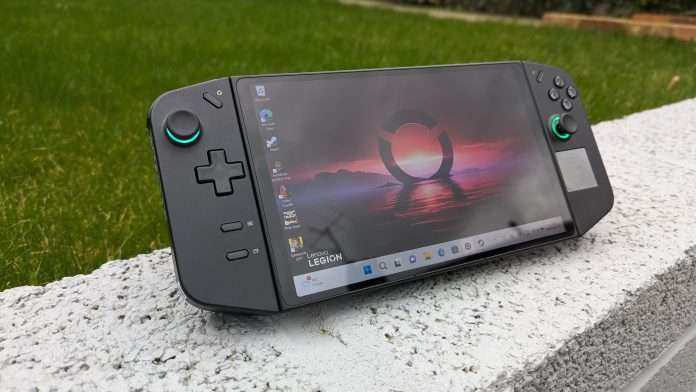
As far as portable gaming consoles go, the Lenovo Legion Go ticks all the right boxes. With a sizeable display to make games shine, immaculate controls that are comfortable to use, and a unique form factor that allows for several ways to play (including an innovative FPS mode), you could say Lenovo plucked the Legion Go from a gamer’s dreams.
Even half a year into its shelf life, Lenovo’s first attempt at a PC gaming handheld manages to stand out. And, thanks to its powerful internals, it has no problems offering lean and clean performance across a range of demanding titles.
Now, with the Steam Deck OLED making a bold statement on the portable gaming scene, the MSI Claw arriving with the latest Intel specs, and rumours of a Nintendo Switch 2 coming in 2024 spilling over the floodgate, the Legion Go sits in a strange position of being fresh yet verging on being considered a “last year” product.
Is the Lenovo Legion Go still a worthy gaming handheld? As a brief summary, yes. However, it can’t escape the jank that comes with putting Windows on a handheld device, and it can’t rival the indomitable support (both in-house and community-based) other consoles like the Nintendo Switch and Steam Deck continue to get.
Pros
- Premium, comfortable design
- Stunning 8.8-inch QHD display
- Impressive performance
- Unique FPS mode
Cons
- Disappointing battery life
- Janky OS thanks to Windows
The Lenovo Legion Go is on the pricier end when it comes to gaming handhelds, especially against the Nintendo Switch and Steam Deck OLED — priced from £700 / $700 / €799.
The Legion Go is on par with the Asus ROG Ally at £699 (although currently discounted to £549) / $699, both pricier than the priciest Steam Deck OLED at around £569 / $549. The Lenovo Legion Go boasts a few more bells and whistles, including a bigger display with up to 2560 x 1600 resolution, a 144Hz refresh rate, detachable controllers, and up to a 1TB SSD. But, as you’ll see below, better specs don’t mean a better console.
Here’s a breakdown of the Legion Go’s specs.
| Processor | AMD Ryzen Z1 Extreme with AMD RDNA Graphics |
| RAM | 16GB LPDDR5X |
| Storage | 256GB / 512GB / 1TB PCIe 4.0 NVMe M.2 |
| Display | 8.8-inch QHD+ (2560 x 1600) IPS; 16:10 aspect ratio; 10-point Touch (144Hz / 60hz refresh rate) |
| Battery | 49.2WHr / 900mAh (controllers) |
| Connectivity | Wi-Fi 6E / Bluetooth 5.2 |
| Size | 11.8 x 5.15 x 1.61 inches (with controllers) / 8.27 x 5.15 x 0.79 (without controllers) |
| Weight | 1.88 pounds (with controllers) / 1.41 pounds (without controllers) |
| OS | Windows 11 |
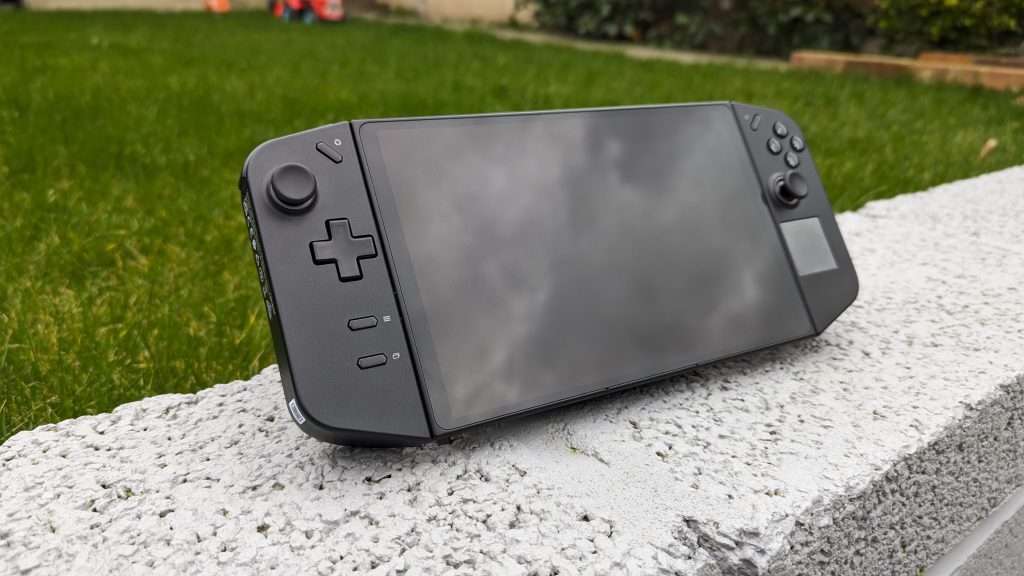
Lenovo Legion Go Design
The Legion Go is a fine piece of portable tech – and a sturdy one at that. Coming in 11.8 x 5.15 x 1.61 inches, it stops short of looking too big and bulky, especially with the angular look of the Legion TrueStrike controllers attached. However, when picking it up and using it as a handheld, I found it to be a fitting size for PC portable gaming.
Its large display and well-designed controllers made for a comfortable gaming experience, and my thumbs could still reach over to the touchscreen display. Moreover, buttons are placed in ideal positions and feel punchy, while the joystick feels excellent. Don’t expect any joystick drift in the long run, as they feature “hall effect joysticks,” which the company claims will offer no joystick drift and minimal dead zones.
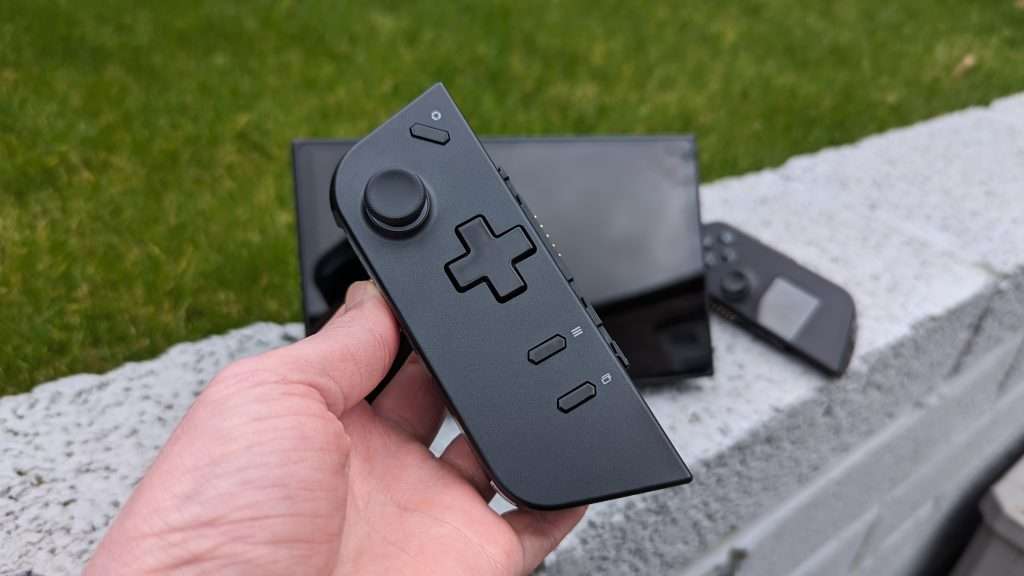
Speaking of the controllers, they also have buttons on the back that lie just under your fingers. These are handy as extra buttons for gaming, but they especially come in handy when the right controller becomes a mouse. That’s right; you can easily detach the controllers, pop open the kickstand, flip on a switch at the bottom, place the right controller in an included controller base and voilà! You have a joystick-like, impromptu mouse.
It may look slightly odd at first, but it looks and acts like a proper mouse for gaming. Those bumper buttons at the back act as the left and right mouse clicks, and it glides along surfaces as a mouse should. It’s called FPS mode, finally making proper FPS gaming portable. Oh, and there’s a mouse wheel on the back of the right controller, just for good measure.
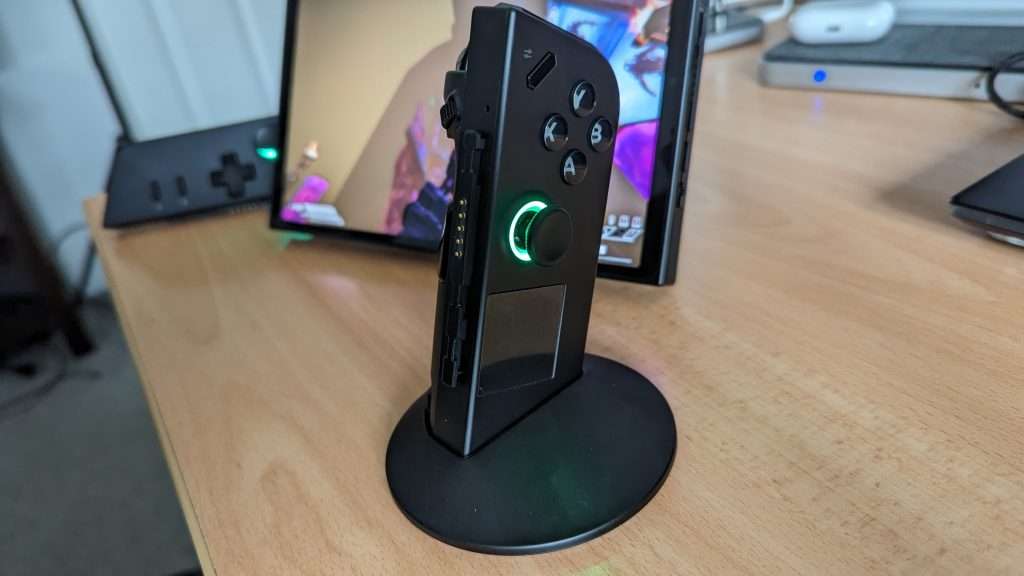
All this works intuitively, too. I found detaching and attaching the controllers simple, but not nearly as easy as the Switch’s Joy-Cons.
Weighing 1.88 pounds, the Legion Go isn’t the lightest gaming handheld (Steam Deck and ROG Ally are 1.48 pounds and 1.34 pounds, respectively). That said, it didn’t feel too heavy when holding it, but I could feel the weight of it after long periods. That said, resting my elbows on a countertop or using its adjustable back stand meant I rarely had to lift it to play.
Another minor point is its air vent. This is a gaming PC in your hands, after all, so it needs to have some cooling. This is placed at the top of the handheld, meaning air virtually always blows away from you. I didn’t notice its fans blowing air until I looked for it. It’s a small design choice I appreciate, as it keeps hot air away from you when tucking into demanding games.
The Legion Go doesn’t slack on ports, either. It’s fitted with a dual USB-C with support for USB 4.0, DisplayPort 1.4 and Power Delivery 3.0, and a handy 3.5mm headphone jack and microSD card reader, extending storage to up to 2TB. You can also expect Wi-Fi 6E and Bluetooth 5.2 connectivity.
All in all, Lenovo has put a lot of thought into the Legion Go’s design, and it shows.
Lenovo Legion Go Display
A big part of the Legion Go’s design is its sizeable 8.8-inch display. The device’s bigger size gives you more screen real estate than other gaming handhelds, which gave me more reason to use its sturdy kickstand and place it on a desk – something I rarely do with my Nintendo Switch.
The Legion Go is equipped with an 8.8-inch QHD+ (2560 x 1600) IPS Pure Sight touchscreen display with a 16:10 aspect ratio, up to a 144Hz refresh rate, 97% DCI-P3 colour gamut coverage and 500 nits of brightness.
Playing games like Cyberpunk 2077, Monster Hunter Rise, and more really pop on this display (even when outdoors), and I couldn’t get enough of how big it all felt compared to my Nintendo Switch.
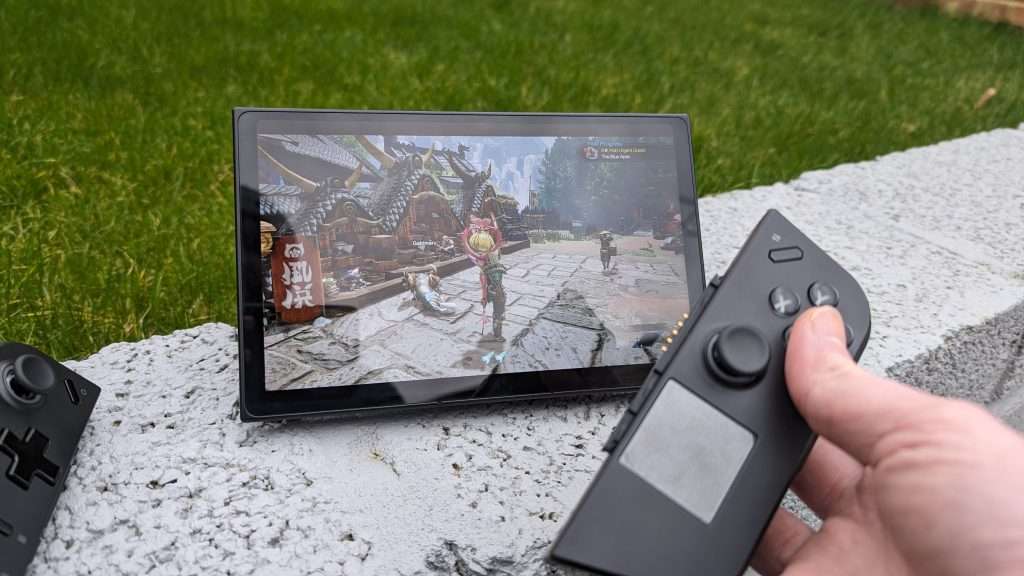
There are a few display options to choose from, depending on what you use the handheld for. It supports resolutions from 800p to 1600p and refresh rates from 60Hz to 144Hz. Along with its relatively high rate of brightness, the display offered crisp, smooth navigation throughout its apps. Moreover, you can expect buttery-smooth frame rates and vivid gameplay if you get the settings just right in games.
Even better, if something doesn’t look great onscreen, you can hook it up to a display thanks to its USB-C ports with DisplayPort 1.4 support. This will mirror the Legion Go’s screen onto whatever display it’s connected to, giving users yet another way to use it.
Lenovo Legion Go Gaming
This is where the Legion Go can shine. This portable console offers impressive performance thanks to its AMD Ryzen Z1 Extreme chip, 16GB of DDR5X RAM, and 512GB of storage (on the review unit).
Of course, there’s a limit to how much a portable console can manage. However, for indie titles and games that don’t emphasise graphics or ray tracing (e.g. Persona 3 Reload, Risk of Rain 2, Turbo Overkill, Pizza Tower, Dave the Diver, etc), the Legion Go works a treat.
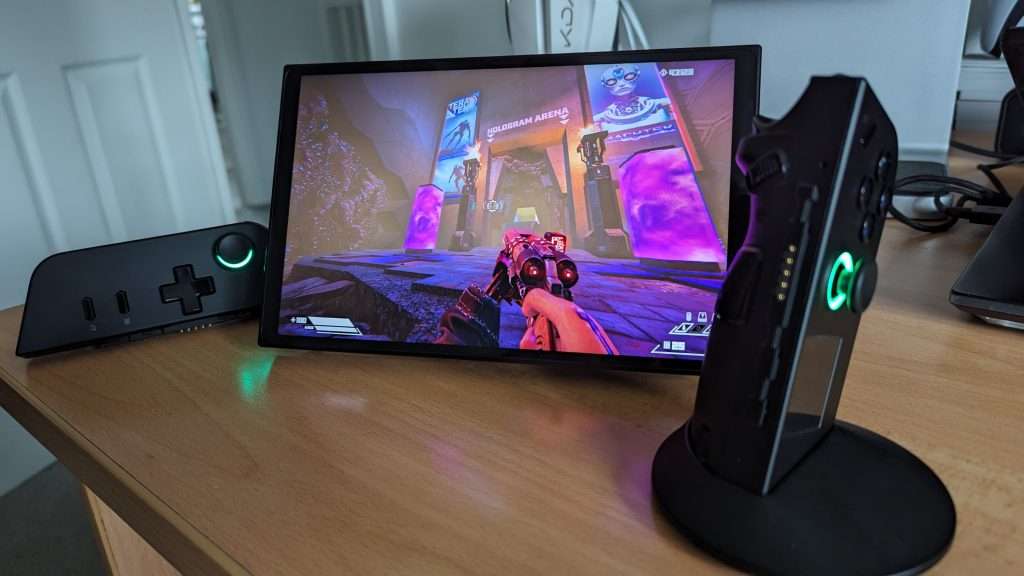
I checked out Turbo Overkill, one of the best FPS games coming out of 2023, to give FPS mode a whirl. I was excited by this, and I got the whole experience by using its 144Hz refresh rate at 1920 x 1200 resolution. Popping the controller in the mouse holder, I quickly moved the camera around without any hiccups. It only took a little time to get to grips with the buttons and using the left TrueStrike as a normal controller, and I was soon jumping, shooting, and sliding my way around the map – until I couldn’t.
The problem is that there are only so many button inputs the TrueStrike controllers have in FPS mode when compared to a keyboard. It’s only mimicking mouse and keyboard button configurations, not creating a new layout. Because of this, I couldn’t use an essential tool in the game: the grapple hook. In FPS mode, there was no default button for it. It meant I couldn’t reach a certain point, so I returned to the usual controller mode. Otherwise, I got excellent performance out of the game.
It shows that some games aren’t optimised for the Legion Go’s FPS mode. That’s to be expected, so it’s just a matter of using it for suitable games. For example, Fortnite, Apex Legends, and even Cyberpunk 2077.
Speaking of, Cyberpunk 2077 is an absolute blast to play. With the right settings (ray tracing off and a mix of medium and high graphics similar to this), I was fully using the 144Hz refresh rate and 2560 x 1600 resolution. Plus, FPS mode made combat similar to what I’d experience with a proper PC setup. The problem is I didn’t get to play it for very long without it being plugged in (more on that later).
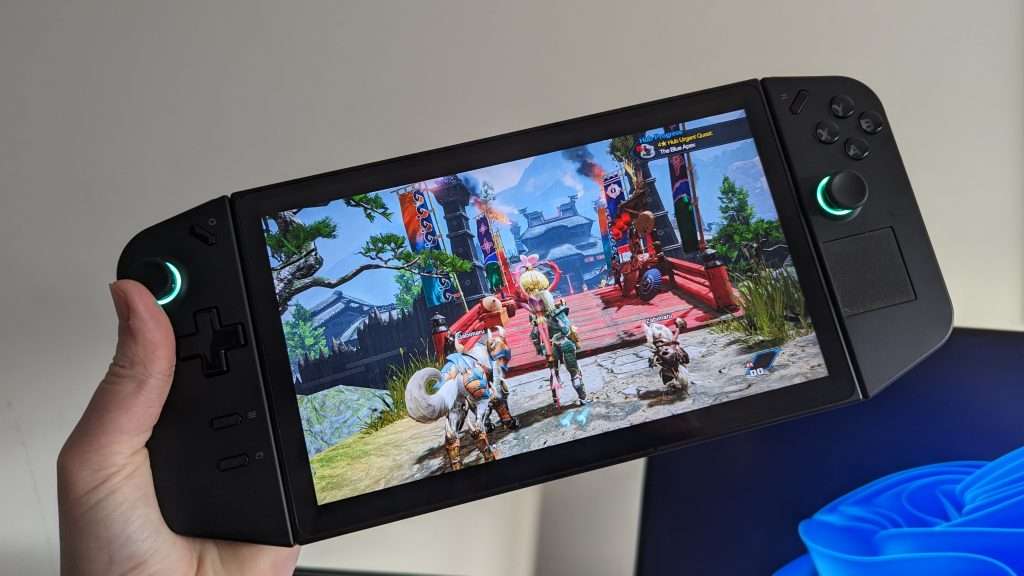
As a fitting comparison to the Nintendo Switch, I booted up Monster Hunter Rise on Steam with 1920 x 1200 resolution at 144Hz. It states that the “Xbox controller” is mostly compatible, similar to Turbo Overkill. I was expecting the same button configuration as the Switch, just swapped with keyboard icons instead of button prompts, but it took me about 15 minutes to realise I needed to use the mouse scroll wheel to get past the user agreement screen (what a palaver).
Unfortunately, this continued, as the touchscreen and mouse wheel were the only functions that worked. As annoying as it is for this to happen, especially if you’re not one to tinker with settings, simply heading to key mapping settings for the controllers can fix this problem. I was able to get it working (the game switched to PlayStation button icons), and I got the full joy out of slaying gigantic monsters with my satisfyingly absurd great sword.
That’s the thing about the Legion Go; some games, especially older ones, won’t be optimised for it. My Steam library consists of classics like STALKER, FEAR, and Max Payne (which admittedly needs fixes to even start up modern PCs), and these titles aren’t designed with controllers in mind – let alone a unique portable console.
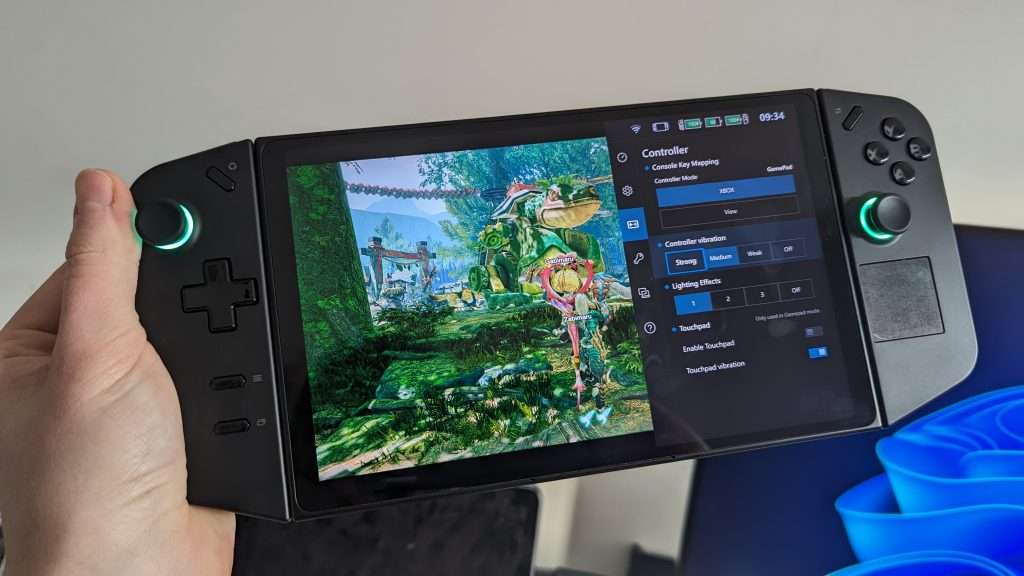
Fiddling with key mapping can gain some rewarding results, but not everyone has the patience or time to even bother. Some just want things to work, and the Legion Go can’t always offer that. On the other hand, the Steam Deck will give you a full list of optimised games.
That aside, compared to the Switch, the Legion Go is now my preferred way to play Monster Hunter Rise and most games of the like. The Legion Go’s big, bright display and smooth frame rates, snug controllers with precise button feel, and the ability to seamlessly detach these controllers on the fly like the Switch make this portable console a treat. It’s almost as if this is what Nintendo would deem a “Switch 2,” of sorts.
Lenovo Legion Go User Interface
As with many PC gaming handhelds, the Lenovo Legion Go runs on Windows. In many ways, this is ideal, as it gives you the full breadth of a standard PC – like using a browser to scroll through the web, stream content, and navigate through apps as you would on a computer. Problem is, this isn’t a genuine PC, and Windows continues to have a hard time accepting that.
From long boot-up times and sometimes struggling to decipher between using its desktop interface or controls in games to apps refusing to work, navigating through the Legion Go can be frustrating. As an example, while the touch screen is handy, touch inputs aren’t very intuitive, as I found myself repeatedly tapping the screen just to select an icon.
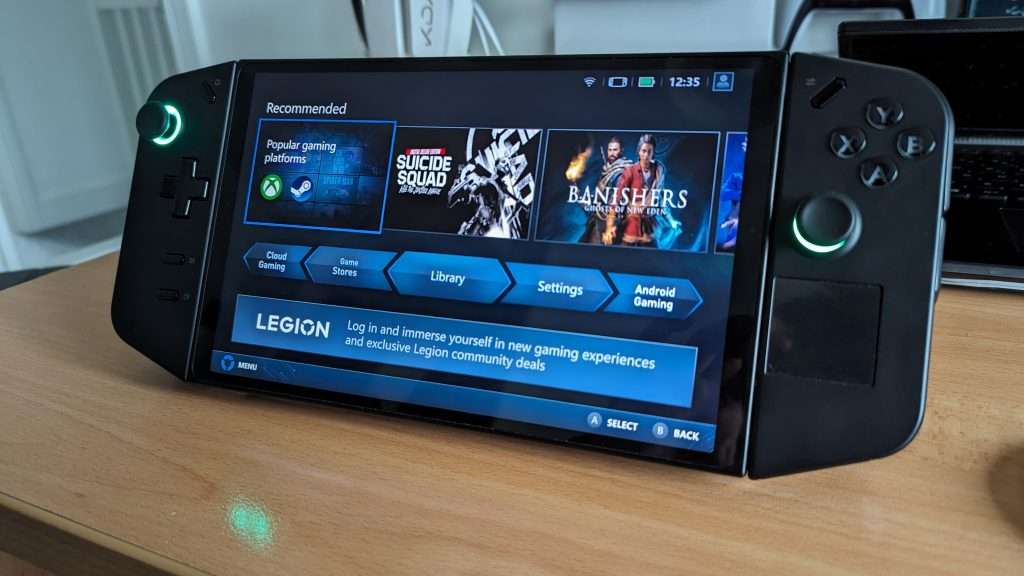
Thankfully, Lenovo’s own Legion Space user interface will save you from a lot of the faff. Game platforms and stores like Steam, Xbox Game Pass, Epic Games Store, Android games, and more can be easily accessed through Legion Space, and it was great to navigate around. You can see and access installed games, buy titles in different stores and adjust settings such as resolution, refresh rate and brightness – all in the app. It’s the handheld’s home app, but you can also switch to Windows 11 as your main screen at any point when it turns on.
Legion Space is good enough to navigate around, but it’s fairly basic and can be clunky. Launching games on their dedicated game clients still takes some time, and I didn’t find myself delving into it all that much.
Lenovo Legion Go Battery
Two words: Not enough.
The Legion Go has a 49.2Wh battery capacity and supports “Super Rapid Charging,” which Lenovo claims can recharge the battery to 70% in 30 minutes. For the most part, Lenovo hit the nail on the head for the console’s charging speeds, but it’s definitely needed since the battery can drain just as quickly.
Depending on the game, I got about 1-3 hours of battery life before the Legion Go died. Even from less demanding titles like Pizza Tower or Dave the Diver, it could only stretch out to 3 hours. For other games, namely Monster Hunter Rise, I could just about manage over an hour (aka one long monster hunt) before putting it on charge. For Cyberpunk 2077? Just about 1 hour. Not ideal when the Nintendo Switch can get well over 3 hours for most games (up to 9 with the OLED model).
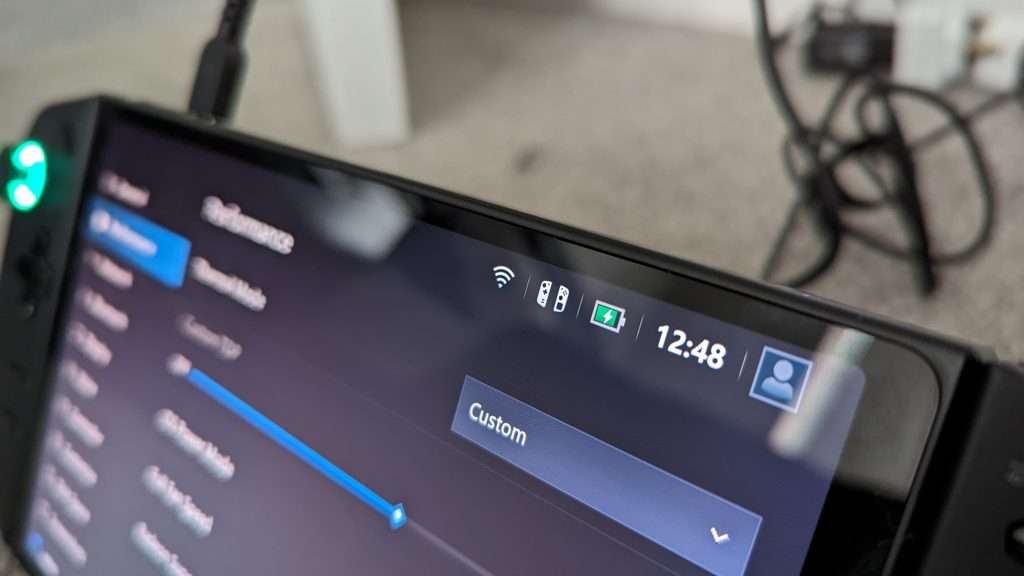
I realise PC games played on higher resolutions and faster frame rates can take a lot of juice, especially on a handheld device. Still, there’s hardly much point in the Legion Go offering these high-spec options if they heavily interfere with battery life. I’d prefer a longer gameplay session on a portable device that handles the Legion Go can reach.
It’s important to note that the Legion Go can get a little hot under the hood, but I never experienced any overheating. Fans got loud, and the ability to change fan speeds for the type of game being played is handy.
Should you buy the Lenovo Legion Go?
It’s clear there are some bright minds behind the making of the Lenovo Legion Go. It’s everything you could want in a portable gaming console, from its impressive performance, allowing you to play Triple-A titles on the go, to its fantastic design, allowing you to play the way you want.
However, it can’t escape being a third-party device. That’s not exactly a bad thing since it gives you plenty of platforms – such as Steam, Xbox Game Pass, GOG, and more – to play on, but it won’t have its own set of games like the Nintendo Switch or a streamlined OS made for a particular client like the Steam Deck.
That last point is particularly irritating, as it makes the Legion Go’s user interface a jarring experience. Sometimes, getting around apps and launching games can be sluggish, and some things may not work the way they’re supposed to the first time. At least the Legion Go gives you plenty of options to tinker with to get things working.
It may seem like I’m laying into Lenovo’s portable PC console hard here. Still, it’s only because the Legion Go’s overall design and useability are something I recommend for gamers needing a way to play a huge library of PC games wherever and however they want.
If you don’t mind fiddling around in settings to get the perfect resolution, frame rate, and controls for different games and want to go beyond the confines of Steam, the Lenovo Legion Go is right up your street. But for $700 / £700, it can be a disappointingly clunky experience.
